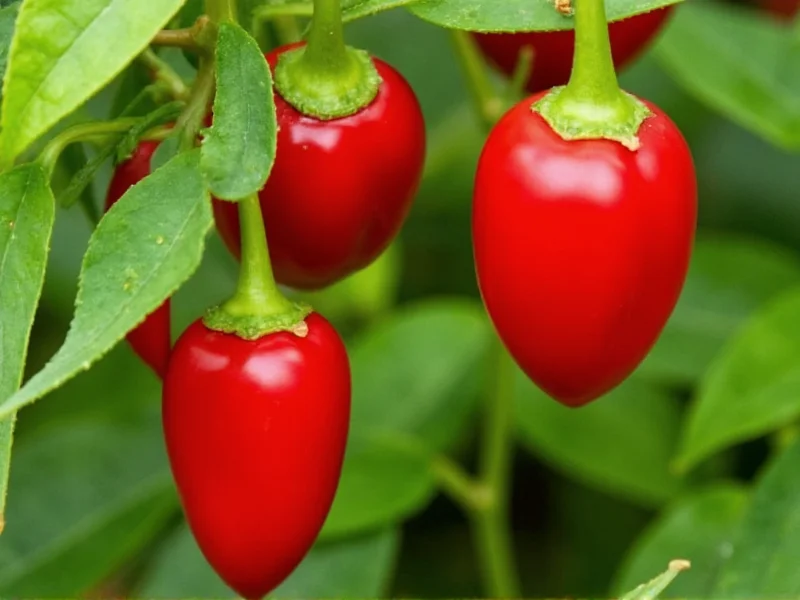When exploring the heat comparison between red and green jalapeños, it's essential to understand the ripening process and its impact on capsaicin—the compound responsible for chili pepper heat. Jalapeños begin their life cycle as green peppers and gradually ripen to red when left on the plant longer. This maturation process affects both flavor and heat characteristics in ways many home cooks and spice enthusiasts misunderstand.
The Science Behind Jalapeño Ripening and Heat Levels
Jalapeños undergo significant chemical changes as they mature from green to red. During this ripening process, the pepper's sugar content increases while capsaicin levels often decrease. Capsaicin, the active component that produces the burning sensation, is concentrated primarily in the pepper's placenta (the white ribs inside) and seeds.
Research shows that jalapeños harvested while still green tend to have higher capsaicin concentrations than those allowed to fully ripen to red. The extended time on the plant allows for metabolic processes that convert some capsaicin into other compounds, resulting in a milder heat profile. However, environmental factors like water stress, soil conditions, and sunlight exposure can influence heat levels regardless of color.
Red vs. Green Jalapeños: Key Differences
| Characteristic | Green Jalapeños | Red Jalapeños |
|---|---|---|
| Harvest Time | 60-70 days after flowering (immature) | 90+ days after flowering (fully mature) |
| Heat Level (SHU) | 2,500-8,000 Scoville Heat Units | 2,500-5,000 Scoville Heat Units |
| Flavor Profile | Grassy, vegetal, brighter heat | Sweeter, fruitier, more complex |
| Texture | Firmer, crisper | Softer, slightly wrinkled |
| Common Uses | Salsas, pickling, fresh applications | Sauces, roasting, drying for chipotles |
Factors That Actually Determine Jalapeño Heat
While color provides some indication of maturity, several other factors significantly impact jalapeño heat levels:
- Genetic variation: Different jalapeño cultivars naturally produce varying heat levels
- Environmental stress: Drought conditions can increase capsaicin production
- Soil composition: Nutrient availability affects capsaicin synthesis
- Harvest timing: Even within the same color stage, heat can vary based on exact harvest time
- Storage conditions: Heat can intensify slightly after harvest as enzymes continue working
Interestingly, the white pithy ribs inside the pepper contain the highest concentration of capsaicin, not the seeds as commonly believed. When preparing jalapeños for cooking, removing these ribs significantly reduces heat regardless of the pepper's color.
Practical Implications for Cooking
Understanding the red versus green jalapeño heat difference has real culinary applications. Green jalapeños work best when you want a brighter, sharper heat in fresh salsas, guacamole, or as pickled peppers. Their firm texture holds up well to various preparation methods.
Red jalapeños, with their sweeter, more complex flavor profile, excel in cooked applications like sauces, stews, and roasted dishes. Their milder heat allows other flavors to shine through while still providing that characteristic jalapeño kick. Many professional chefs prefer using red jalapeños for sauces where a balanced heat is desired.
For those specifically seeking maximum heat from jalapeños, look for smaller peppers with visible striations (corking) on the skin, regardless of color. These physical characteristics often indicate higher stress during growth, which typically correlates with increased capsaicin production.
Debunking Common Pepper Color Myths
Many people assume that red chilies are always hotter than green ones, but this generalization doesn't hold true across all pepper varieties. While it's accurate for some peppers like serranos (which do get hotter as they ripen), jalapeños follow the opposite pattern.
The misconception likely stems from comparing different pepper varieties rather than the same variety at different ripeness stages. A red habanero is indeed much hotter than a green jalapeño, but that's comparing two different pepper types, not the same pepper at different maturity levels.
When evaluating heat potential, always consider the specific pepper variety first, then its maturity stage, growing conditions, and physical characteristics—not just color alone.
Conclusion: Choosing the Right Jalapeño for Your Needs
When deciding between red and green jalapeños, consider both heat preferences and flavor profiles. Green jalapeños typically deliver a sharper, more immediate heat that works well in fresh applications, while red jalapeños offer a more rounded, slightly sweeter experience better suited for cooked dishes.
For consistent results in your cooking, taste-test peppers before using them extensively in recipes. Individual jalapeños can vary dramatically in heat—even within the same batch—so personal testing remains the most reliable method for predicting their impact on your dish.
Frequently Asked Questions
Why do some red jalapeños seem hotter than green ones?
While red jalapeños are generally milder, individual peppers can vary significantly due to growing conditions. A red jalapeño grown under stressful conditions (like drought) might be hotter than a green one grown in ideal conditions. The variation between individual peppers often outweighs the typical color-based difference.
Do red jalapeños turn green if picked early?
No, the color progression only moves in one direction. Jalapeños start green and ripen to red. Green jalapeños are simply unripe versions of what will eventually become red jalapeños if left on the plant. Once picked, they may continue ripening to red but won't revert to green.
Can I substitute red jalapeños for green in recipes?
Yes, but with flavor adjustments. Since red jalapeños are sweeter and milder, you may need to use more for equivalent heat. Consider reducing added sugar in the recipe to balance the natural sweetness of red jalapeños. The substitution works best in cooked dishes rather than fresh applications where texture differences are more noticeable.
How does the heat of jalapeños compare to other common peppers?
Jalapeños (2,500-8,000 SHU) are milder than habaneros (100,000-350,000 SHU) but hotter than poblanos (1,000-2,000 SHU). Compared to other jalapeño relatives, serranos (10,000-23,000 SHU) are consistently hotter, while gueros (5,000-10,000 SHU) are similar but often slightly milder. Bell peppers (0 SHU) contain no capsaicin.











 浙公网安备
33010002000092号
浙公网安备
33010002000092号 浙B2-20120091-4
浙B2-20120091-4